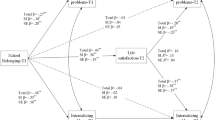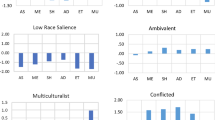Abstract
This study examined the relationship of self-concept, school belonging, school engagement to school performance of Caucasian- and African-American students. The main purpose is to assess the ethnicity-based differences in these psycho-social constructs and to explore their differential relationship to school achievement in high-school students from different ethnic background. The data were collected through a survey questionnaire in three school divisions in the Southwest region of Virginia of the United States. The results showed significant ethnicity-based difference in self-concept and in school engagement, but no significant difference in school belonging. The achievement differences were also significant, Caucasian students being higher on self-reported grades. In the regression model, self-concept was not a significant predictor of school outcomes, while school belonging had a significant relationship to school achievement for African-American students. Both self-concept and school engagement were significant for Caucasian students. The findings of the study provide better understanding of the relationship of these variables to school achievement and point to some policy-relevant implications.
Similar content being viewed by others
References
Ainsworth-Darnell J. W., Downey D. B. (1998) Assessing the oppositional culture explanation for racial/ethnic differences in school performance. American Sociological Review 63: 536–553
Allen W. R., Haniff N. Z. (1991) Race, gender, and academic performance in U.S. higher education. In: Allen W. R., Epps E. G., Haniff N. Z. (eds) College in Black and White. State University of New York Press, Albany, NY, pp 95–109
Baumeister R. F., Leary M. R. (1995) The need to belong: Desire for interpersonal attachments as a fundamental human motivation. Psychological Bulletin 117: 497–529
Booker K. C. (2006) School belonging and the African American adolescent: What do we know and where should we go?. The High School Journal 89(4): 1–7
Bracken, B. A. (1992). Examiner’s manual for the Multidimensional Self-Concept Scale (Pro ed.). Austin, TX.
Brewster A. B., Bowen G. L. (2004) Teacher support and the school engagement of Latino middle and high school students at risk of school failure. Child and Adolescent Social Work Journal 21(1): 47–67
Brigham J. C. (1974) Views of Black and White children concerning the distribution of personality characteristics. Journal of Personality and Social Psychology 42: 144–158
Byrne B. M. (1984) The general/academic self-concept nomological network: A review of construct validation research. Review of Educational Research 54: 427–456
Chavous T. M., Bernat D., Schmeelke-Cone K., Caldwell C., Kohn-Wood L. P., Zimmerman M. (2003) Racial identity and academic attainment among African American adolescents. Child Development 74(4): 1076–1091
Connell J. P., Spencer M. B., Aber J. L. (1994) Educational risk and resilience in African-American youth: Context, self, action, and outcomes in school. Child Development 65: 493–506
Cooley C. H. (1956) Human nature and the social order. Free Press, New York
Cothran D. J., Ennis C. D. (2000) Building bridges to student engagement: Communicating respect and care for students in urban high schools. Journal of Research and Development 65: 493–506
Crain R. M., Bracken B. A. (1994) Age, race, and gender differences in child and adolescent self-concept: Evidence from a behavioral-acquisition, context-dependent model. School Psychology Review 23: 496–511
Crocker J., Major B. (1989) Social stigma and self-esteem: The self-protective properties of stigma. Psychological Review 96: 608–630
Demo D. H., Parker K. D. (1987) Academic achievement and self-esteem among Black and White college students. Journal of Social Psychology 127: 345–355
Dika, S. L., & Singh, K. (2002). Measuring academic engagement: A confirmatory factor analysis. Unpublished manuscript.
Duncan G. J., Magnuson K. (2005) Can family socioeconomic resources account for racial and ethnic test score gaps?. The Future of Children 15: 35–54
Eccles J. S., Midgley C. (1989) Stage-environment fit: Developmentally appropriate classrooms for young adolescents: Vol. 3. Goals and cognitions. In: Ames C., Ames R. (eds) Research on motivation in education. Academic Press, New York, pp 13–44
Festinger L. (1954) A theory of social comparison process. Human Relations 7: 117–140
Finn J. D. (1989) Withdrawing from school. Review of Educational Research 59(2): 117–142
Finn J. D., Voelkl K. E. (1993) School characteristics related to student engagement. Journal of Negro Education 62(3): 249–268
Fleming J. S., Courtney B. E. (1984) The dimensionality of self-esteem: II. Hierarchical facet model for revised measurement scales. Personality and Social Psychology Bulletin 46(2): 404–421
Fredricks J. A., Blumenfeld P. C., Paris A. H. (2004) School engagement: Potential of the concept, state of the evidence. Review of Educational Research 74: 59–109
Fredricks J. A., Eccles J. S. (2002) Children’s competence and value beliefs from childhood through adolescence: Growth trajectories in two male-sex-typed domains. Developmental Psychology 38(4): 519–533
Fordham S., Ogbu J. U. (1986) Black students’ school success: Coping with the “burden of ‘acting white’”. Urban Reveiw 18: 176–206
Ford D. (1996) Reversing underachievement among gifted Black students: Promising practices and programs. Teachers College Press, New York
Gaertner S. L., Dovidio J. F. (1986) The aversive form of racism. In: Dovidio J. F., Gaertner S. L. (eds) Prejudice, discrimination, and racism. Academic Press, New York, pp 61–90
Goodenow C. (1993) The psychological sense of school membership among adolescents: Scale development, and educational correlates. Psychology in the Schools 30: 79–90
Goodenow C., Grady K. E. (1993) The relationship of school belonging and friends’ values to academic motivation among urban adolescent students. Journal of Experimental Education 62(1): 60–71
Graham S. (1994) Motivation in African Americans. Review of Educational Research 64: 55–117
Gray-Little B., Hafdahl A. R. (2000) Factors influencing racial comparisons of self-esteem: A quantitative review. Psychological Bulletin 126(1): 26–54
Harris-Britt A., Valrie C. R., Kurtz-Costes B., Rowley S. J. (2007) Perceived racial discrimination and self-esteem in African American youth: Racial socialization as a protective factor. Journal of Research on Adolescence 17(4): 669–682
Hudley C. A. (1997) Issues of race and gender in the educational achievement of African-American children. In: Bank B., Hall P. (eds) Gender, equity, and schooling: Policy and practice. Garland, New York
Johnson M. K., Crosnoe R., Elder G. H. Jr (2001) Students’ attachment and academic engagement: The role of race and ethnicity. Sociology of Education 74: 318–340
Jordan, W., & Nettles, S. (1999). How students invest their time out of school: Effects on school engagement, perceptions of life chances, and achievement (No. 38). Baltimore, MD: Center for Research on the Education of Students Placed at Risk.
Lamborn S., Brown B., Mounts N., Steinberg L. (1992) Putting school in perspective: The influence of family, peers, extracurricular participation, and part time work on academic engagement. In: Newmann F. (eds) Student engagement and achievement in American secondary schools. Teachers College, New York, pp 153–181
Major, B., & Crocker, J. (1993). Social stigma: The consequences of attributional ambiguity. In D. M. Mackie & D. L. Hamilton, Affect, cognition, and stereotyping: Interactive processes in group perception. San Diego, CA: Academic Press.
Major B., Spencer S., Schmader T., Wolfe C., Crocker J. (1998) Coping with negative stereotypes about intellectual performance: The role of psychological disengagement. Personal Social Psychology Bulletin 24(1): 34–54
Marsh H. W. (2005) Self-concept theory, measurement and research into practice: The role of self-concept in educational psychology. British Psychological Society, Leicester
Marsh H. W., Craven R. G. (2006) Reciprocal effects of self-concept and performance from a multidimensional perspective: Beyond seductive pleasure and unidimensional perspectives. Perspectives on Psychological Science 1: 133–163
Mboya M. M. (1986) Black adolescents: A descriptive study of their self-concepts and academic achievement. Adolescence 21: 689–696
Mead G. H. (1934) Mind, self, and society. University of Chicago Press, Chicago
Mullis, I. V. S., Campbell, J., & Farstrup, A. (1993). NAEP 1992 reading report card for the nation and the states. U.S. Department of Education: Office of Educational Research and Improvement.
National Assessment of Educational Progress (NAEP). (2008). The nation’s report card. Retrieved January 20, 2008 from http://nationsreportcard.gov/tuda_reading_mathematics_2005/t0006.asp?subtab_id=Tab_5&tab_id=tab1&printver=#chart.
National Center for Education Statistics: (2007) Status and Trends in the education of racial and ethnic minorities. US Department of Education, Washington, DC
Newmann, F., Wehlage, G., & Lamborn, S. (1992). The significance and sources of student engagement. In F. Newman, Student engagement and achievement in American secondary schools. New York: Teachers College.
O’ Mara A. J., Marsh H. W., Craven R. G., Debus R. L. (2006) Do self-concept interventions make a difference? A synergestic blend of construct validation and meta-analysis. Educational Psychologist 41: 181–206
Osborne J. (1995) Academics, self-esteem, and race: A look at the underlying assumptions of the disidentification hypothesis. Personal Social Psychology Bulletin 21: 449–455
Osterman K. F. (2000) Students’ need for belonging in the school community. Review of Educational Research 70: 323–367
Roscigno V. J., Ainsworth-Darnell J. W. (1999) Race, cultural capital, and educational resources: Persistent inequalities and achievement returns. Sociology of Education 72(3): 158–178
Rosenberg M. (1965) Society and the adolescent self-image. Princeton University Press, Princeton, NJ
Rosenberg M., Schooler C., Schoenbach C., Rosenberg F. (1995) Global self-esteem and specific self-esteem: Different concepts, different outcomes. American Sociological Review 60: 141–156
Ryan R. M., Deci E. L. (2000) Self-determination theory and the facilitation of intrinsic motivation, social development, and well-being. American Psychologist 55: 68–78
Sánchez B., Colón Y., Esparza P. (2005) The role of sense of school belonging and gender in the academic adjustment of Latino adolescents. Journal of Youth and Adolescence 34(6): 619–628
Shavelson R. J., Hubner J. J., Stanton G. C. (1976) Self-concept: Validation of construct interpretations. Review of Educational Research 46: 407–441
Singh K., Granville M., Dika S. (2002) Mathematics and science achievement: Effects of motivation, interest, and academic engagement. Journal of Educational Research 95(6): 323–333
Skinner E. A., Wellborn J. G., Connell J. P. (1990) What it takes to do well in school and whether I’ve got it: A process model of perceived control and children’s engagement and achievement in school. Journal of Educational Psychology 82(1): 22–32
Smerdon B. A. (1999) Engagement and achievement: Differences between African-American and White students. Research in Sociology of Education and Socialization 12: 103–134
Steele, C. M. (1992, April). Race and the schooling of Black Americans. Atlantic Monthly, 68–78.
Steele C. M. (1997) A threat in the air: How stereotypes shape the intellectual identity and performance. American Psychologist 52: 613–629
Steinberg L. D., Brown B. B., Dornbusch S. M. (1996) Beyond the classroom: Why school reform has failed and what parents need to do. Simon & Schuster, New York
Steinberg L. D., Lamborn S., Dornbusch S. M., Darling N. (1992) Impact of parenting practices on adolescent achievement: Authoritative parenting, school involvement, and encouragement to succeed. Child Development 63: 1266–1281
Tate W. F. (2004) “Brown,” political economy, and the scientific education of African Americans. Review of Research in Education 28: 147–184
Twenge J. M., Crocker J. (2002) Meta-analysis comparing Whites, Blacks, Hispanics, Asians, and American Indians and comment on Gray-Little and Hafdahl (2000). Psychological Bulletin 128(3): 371–408
van Laar C. (2000) The paradox of low academic achievement but high self esteem in African American students: An attributional account. Educational Psychology Review 12(1): 33–61
Voelkl K. E. (1997) Identification with school. American Journal of Education 105(3): 294–318
Wehlage G., Rutter R., Smith G., Lesko N., Fernandez R. (1989) Reducing the risk: Schools as communities of support. Falmer, New York
Wigfield A. L., Eccles J. S. (2002) Motivational beliefs, values, and goals. Annuall Review of Psychology 53: 109–132
Wills T. A. (1991) Similarity and self-esteem in downward comparison. In: Suls J., Wills T. A. (eds) Social comparison: contemporary theory and research. Lawrence Erlbaum Associates, Hillsdale, NJ, pp 51–78
Author information
Authors and Affiliations
Corresponding author
Rights and permissions
About this article
Cite this article
Singh, K., Chang, M. & Dika, S. Ethnicity, self-concept, and school belonging: effects on school engagement. Educ Res Policy Prac 9, 159–175 (2010). https://doi.org/10.1007/s10671-010-9087-0
Received:
Accepted:
Published:
Issue Date:
DOI: https://doi.org/10.1007/s10671-010-9087-0




